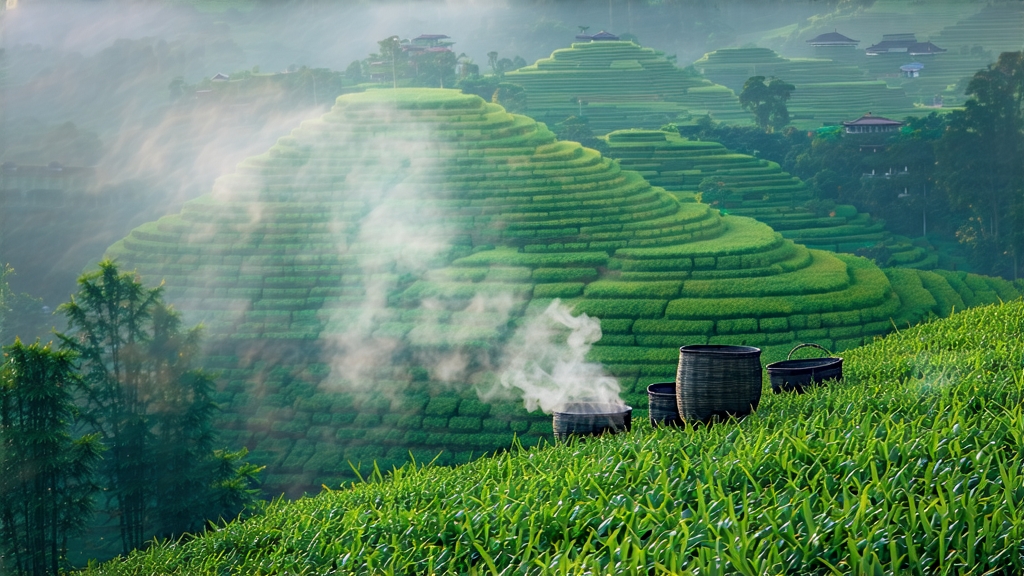
Tucked away in the humid, karst-pocked southwest of China, the city of Wuzhou in Guangxi Province guards a tea secret that once greased the wheels of maritime trade and still whispers of camphor, orchards, and damp earth. Liu Bao—literally “Six Forts”—is the name of a town, a tea, and a taste memory older than the famed Pu-erh it predates. While the world celebrates the Yunnan dark teas that cross borders in cake form, Liu Bao ferments quietly in woven bamboo baskets, acquiring a patina of history that can only be earned, not printed on a label.
Historical footprints
Liu Bao’s story begins during the Qing dynasty’s Qianlong era (1736-1795), when it was compressed into tight baskets, loaded onto flat-bottomed river boats, and floated down the Xunjiang River to the port of Wuzhou. From there it sailed to Hong Kong, Malaysia, and the tin mines of Kuala Lumpur, where Cantonese coolies drank it to cut the grease of coconut rice and to ward off malaria in the tropical heat. In 1801 the governor of Guangxi presented Liu Bao to the imperial court; the emperor’s tasting note—so legend claims—was “sweet after hardship,” a Confucian metaphor that secured the tea’s annual tribute status. When the Malayan railway opened in 1885, Liu Bao became ballast in steamers returning with rubber and tin, embedding itself in Southeast Asian tea culture so thoroughly that grandmothers in Penang still measure wealth by how many 1980s bamboo baskets lie under the bed.
From leaf to basket: the craft
Liu Bao belongs to the hei cha (dark tea) family, yet its microbiology is distinct. The local cultivar is a large-leaf variety called Zhong ye zhong, planted on red-clay hills between 200 and 500 m above sea level. Picking occurs from April to October; one bud with three or four leaves is snapped off, not cut, to keep the vein intact. The first surprise comes immediately after wilting: leaves are plunged into a 150 °C wok for exactly 90 seconds, a kill-green step brief enough to preserve oxidative enzymes that will matter months later. A short rolling follows, just enough to break 30 % of the cell walls, then 24 hours of sun-drying on bamboo trays. At this point the maocha looks like dull green fettuccine and smells of chestnut, but it is still a raw, living material.
The true alchemy begins with “dui wo,” the wet-piling fermentation invented in Wuzhou during the 1950s yet rooted in centuries of folk practice. Five tons of maocha are piled into a rectangular heap, sprayed with mountain spring water until moisture reaches 28 %, and covered with jute sacks. Inside the 1.5-meter mound temperature climbs to 55 °C within 48 hours; every 48 hours the pile is turned, sprayed again, and aerated. Over the next 25 days the tea is literally composting itself, hosting a succession of microbes—Aspergillus niger, Blastobotrys adeninivorans, and a unique yeast dubbed Wuzhouensis LB-1—that oxidize polyphenols into theaflavins, theabrownins, and rare nitrogenous compounds responsible for Liu Bao’s signature “betel-nose” aroma, reminiscent of areca nut, camphor, and damp cellars.
After piling the tea is steamed for three minutes, then packed by hand into cylindrical bamboo baskets woven from three-year-old mao zhu. A skilled worker can fill a 40 kg basket in 20 minutes, tamping just hard enough to leave air channels for micro-oxidation that will continue for decades. The baskets are stacked in humid caves under Wuzhou’s limestone hills where temperature hovers at 22 °C and relative humidity at 85 %. Here Liu Bao sleeps, breathing through bamboo slats, slowly darkening from russet to ebony, trading grassy bitterness for cocoa, orchid, and a cooling menthol that Chinese drinkers call “liang gan”—the sweet coolness that slides down the throat like minted dark chocolate.
Grades and tasting lexicon
Unlike Pu-erh’s mountain-centric terroir labels, Liu Bao is graded by basket weight and leaf maturity:
- First grade (tè jí): tips only, 20 kg baskets, liquor the color of sh